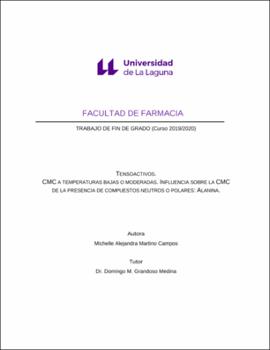Tensoactivos. CMC a temperaturas bajas y moderadas. Influencia sobre la CMC de la presencia de compuestos neutros o polares: alanina.
Fecha
2020Resumen
Se ha estudiado la influencia del aminoácido L-alanina, como compuesto apolar, en la
concentración micelar crítica (CMC) del tensoactivo dodecilsulfato sódico (SDS) en
disoluciones acuosas. Para calcular la CMC se midieron conductividades eléctricas para
diferentes concentraciones de SDS en distintas concentraciones de disolvente (alaninaagua 0.05M, 0.01M, 0.25M, 0.5M y 1M) a diferentes temperaturas (desde 20ºC hasta
40ºC, de cinco en cinco grados).
Los parámetros termodinámicos para el proceso de micelización y los efectos de la
alanina sobre estos, fueron calculados a partir de las variables analizadas con el fin
arrojar información sobre cómo influye la naturaleza del disolvente sobre el poder
tensoactivo del SDS. Los resultados mostraron, que la alanina en las concentraciones
estudiadas actúa directamente sobre la CMC, disminuyéndola a medida que se
incrementa la concentración de ésta. Por otra parte, se determinó la poca influencia que
tiene la temperatura sobre este parámetro, dentro del rango de temperaturas estudiado. Influence of the amino acid L-alanine, as an apolar compound, in the critical micelle
concentration (CMC) of the surfactant sodium dodecyl sulfate (SDS) in aqueous solutions
was studied in this work. To calculate the CMC, electric conductivities were measured for
the different SDS concentrations, using different configurations for the solvent (alanine
0.05M, 0.01M, 0.25M, 0.5M and 1M), at different temperatures (from 20ºC to 40ºC,
changing every five degrees).
The thermodynamic parameters for the micellization process and the effects of the
alanine on them, were calculated from the variables analyzed with the purpose of getting
information on how to influence over the nature of the surfactant power of the SDS. The
results showed, that alanine for the different studied concentrations, acts on SDS CMC,
decreasing as the concentration of alanine increases. On the other hand, the little
influence that temperature has on this parameter was determined, within the range of
temperatures studied.





